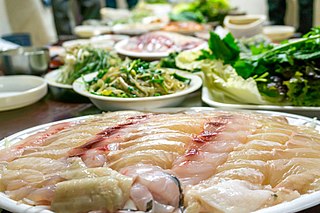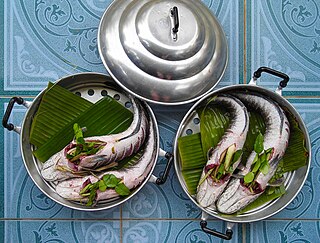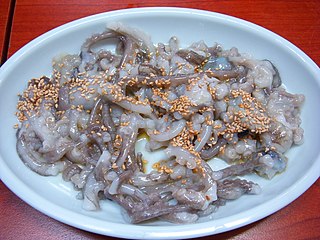
An octopus is a soft-bodied, eight-limbed mollusc of the order Octopoda. The order consists of some 300 species and is grouped within the class Cephalopoda with squids, cuttlefish, and nautiloids. Like other cephalopods, an octopus is bilaterally symmetric with two eyes and a beaked mouth at the centre point of the eight limbs. The soft body can radically alter its shape, enabling octopuses to squeeze through small gaps. They trail their eight appendages behind them as they swim. The siphon is used both for respiration and for locomotion, by expelling a jet of water. Octopuses have a complex nervous system and excellent sight, and are among the most intelligent and behaviourally diverse of all invertebrates.

Seafood is the culinary name for food that comes from any form of sea life, prominently including fish and shellfish. Shellfish include various species of molluscs.

Sashimi is a Japanese delicacy consisting of fresh raw fish or meat sliced into thin pieces and often eaten with soy sauce.

Shellfish is a colloquial and fisheries term for exoskeleton-bearing aquatic invertebrates used as food, including various species of molluscs, crustaceans, and echinoderms. Although most kinds of shellfish are harvested from saltwater environments, some are found in freshwater. In addition, a few species of land crabs are eaten, for example Cardisoma guanhumi in the Caribbean. Shellfish are among the most common food allergens.

Clam is a common name for several kinds of bivalve mollusc. The word is often applied only to those that are edible and live as infauna, spending most of their lives halfway buried in the sand of the sea floor or riverbeds. Clams have two shells of equal size connected by two adductor muscles and have a powerful burrowing foot. They live in both freshwater and marine environments; in salt water they prefer to burrow down into the mud and the turbidity of the water required varies with species and location; the greatest diversity of these is in North America.
Ciguatera fish poisoning (CFP), also known as ciguatera, is a foodborne illness caused by eating reef fish contaminated with ciguatoxins. Such individual fish are said to be ciguatoxic. Symptoms may include diarrhea, vomiting, numbness, itchiness, sensitivity to hot and cold, dizziness, and weakness. The onset of symptoms varies with the amount of toxin eaten. If a lot of toxins are consumed symptoms may appear within half an hour. If a low amount of toxins are consumed symptoms make take a few days to appear. Diarrhea may last up to four days. Symptoms may last a few weeks to a few months. Heart problems such as slow heart rate and low blood pressure may occur.

Diphyllobothrium is a genus of tapeworms which can cause diphyllobothriasis in humans through consumption of raw or undercooked fish. The principal species causing diphyllobothriasis is D. latum, known as the broad or fish tapeworm, or broad fish tapeworm. D. latum is a pseudophyllid cestode that infects fish and mammals. D. latum is native to Scandinavia, western Russia, and the Baltics, though it is now also present in North America, especially the Pacific Northwest. In Far East Russia, D. klebanovskii, having Pacific salmon as its second intermediate host, was identified.

Anisakis is a genus of parasitic nematodes that have life cycles involving fish and marine mammals. They are infective to humans and cause anisakiasis. People who produce immunoglobulin E in response to this parasite may subsequently have an allergic reaction, including anaphylaxis, after eating fish infected with Anisakis species.

Hoe is a Korean seafood dish that is eaten by trimming raw meat or raw fish. The concept of eating raw fish and meat name by hwe(Korean) or Kuai(Chinese) is originated and named from China in ancient time. In addition to fish, it is also made with other marine products such as shrimp and squid, raw meat of land animals, and vegetable ingredients, but without any special prefix, it mainly refers to raw fish.

Many species of fish are caught by humans and consumed as food in virtually all regions around the world. Fish has been an important dietary source of protein and other nutrients.

Ikizukuri (生き作り), also known as ikezukuri (活け造り), is the preparing of sashimi from live seafood. In this Japanese culinary technique, the most popular sea animal used is fish, but octopus, shrimp, and lobster may also be used. The practice is controversial owing to concerns about the animal's suffering, as it is seemingly alive when served.
The Feast of the Seven Fishes is an Italian American celebration of Christmas Eve with dishes of fish and other seafood. It is not a "feast" in the sense of "holiday", but rather a grand meal. Christmas Eve is a vigil or fasting day, and the abundance of seafood reflects the observance of abstinence from meat until the feast of Christmas Day itself.
Diphyllobothriasis is the infection caused by tapeworms of the genus Diphyllobothrium.

Cestoda is a class of parasitic worms in the flatworm phylum (Platyhelminthes). Most of the species—and the best-known—are those in the subclass Eucestoda; they are ribbon-like worms as adults, known as tapeworms. Their bodies consist of many similar units known as proglottids—essentially packages of eggs which are regularly shed into the environment to infect other organisms. Species of the other subclass, Cestodaria, are mainly fish infecting parasites.

Like humans and other animals, fish suffer from diseases and parasites. Fish defences against disease are specific and non-specific. Non-specific defences include skin and scales, as well as the mucus layer secreted by the epidermis that traps microorganisms and inhibits their growth. If pathogens breach these defences, fish can develop inflammatory responses that increase the flow of blood to infected areas and deliver white blood cells that attempt to destroy the pathogens.

Pescetarianism is a dietary practice in which seafood is the only source of meat in an otherwise vegetarian diet. The inclusion of other animal products, such as eggs and dairy, is optional. According to research conducted from 2017 to 2018, approximately 3% of adults worldwide are pescetarian.

A sucker in zoology is a specialised attachment organ of an animal. It acts as an adhesion device in parasitic worms, several flatworms, cephalopods, certain fishes, amphibians, and bats. It is a muscular structure for suction on a host or substrate. In parasitic annelids, flatworms and roundworms, suckers are the organs of attachment to the host tissues. In tapeworms and flukes, they are a parasitic adaptation for attachment on the internal tissues of the host, such as intestines and blood vessels. In roundworms and flatworms they serve as attachment between individuals particularly during mating. In annelids, a sucker can be both a functional mouth and a locomotory organ. The structure and number of suckers are often used as basic taxonomic diagnosis between different species, since they are unique in each species. In tapeworms there are two distinct classes of suckers, namely "bothridia" for true suckers, and "bothria" for false suckers. In digeneal flukes there are usually an oral sucker at the mouth and a ventral sucker posterior to the mouth. Roundworms have their sucker just in front of the anus; hence it is often called a pre-anal sucker.

Eating live animals is the practice of humans eating animals that are still alive. It is a traditional practice in many East Asian food cultures. Animals may also be eaten alive for shock value. Eating live animals, or parts of live animals, may be unlawful in certain jurisdictions under animal cruelty laws. Religious prohibitions on the eating of live animals by humans are also present in various world religions.

People of some cultures eat octopus. The arms and sometimes other body parts are prepared in various ways, often varying by species and/or geography.






















